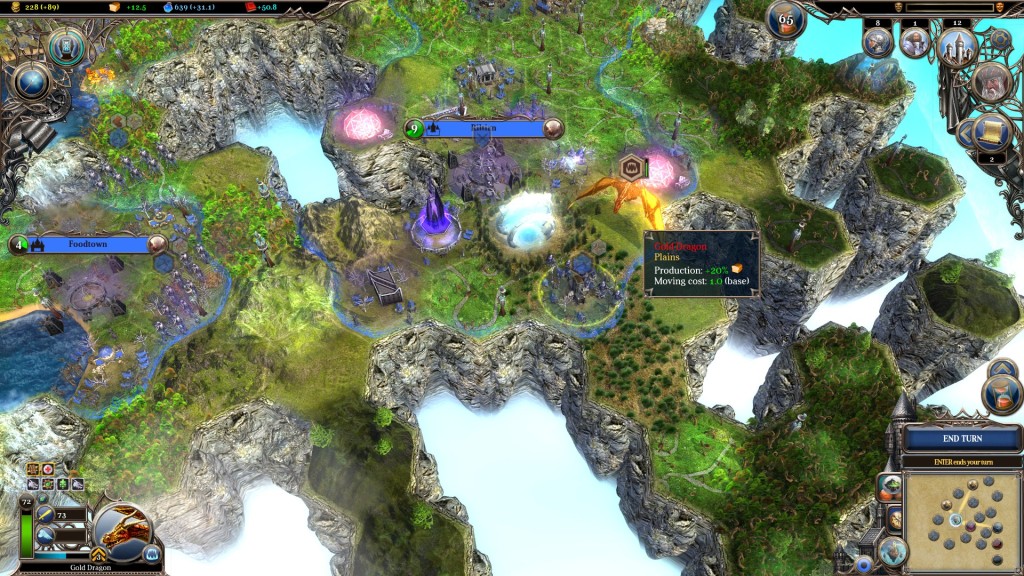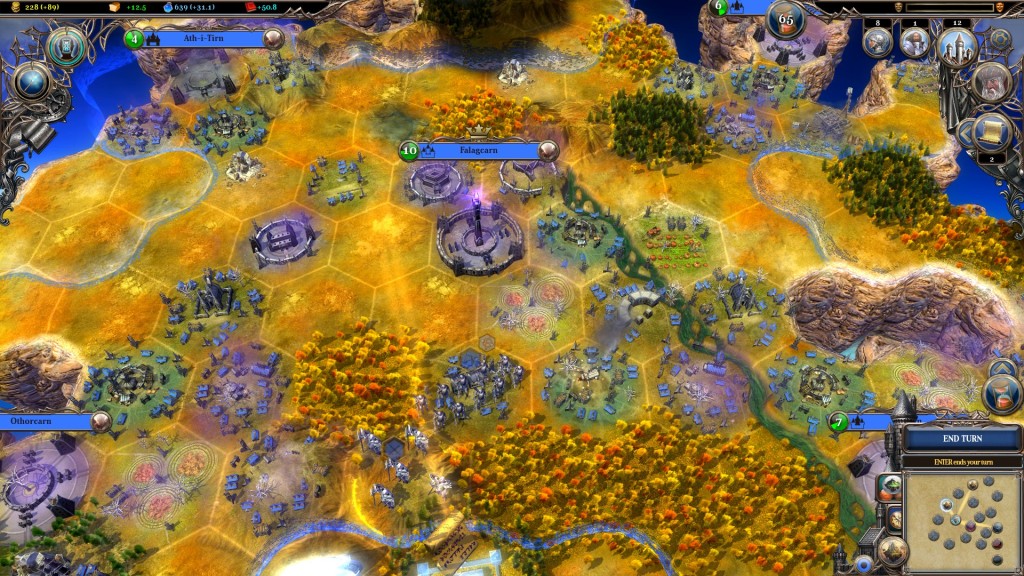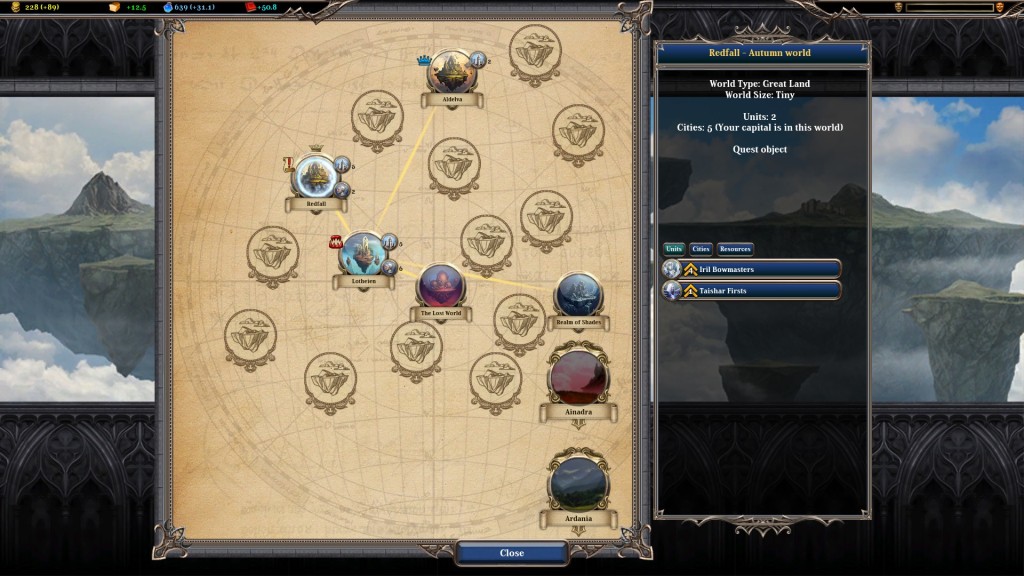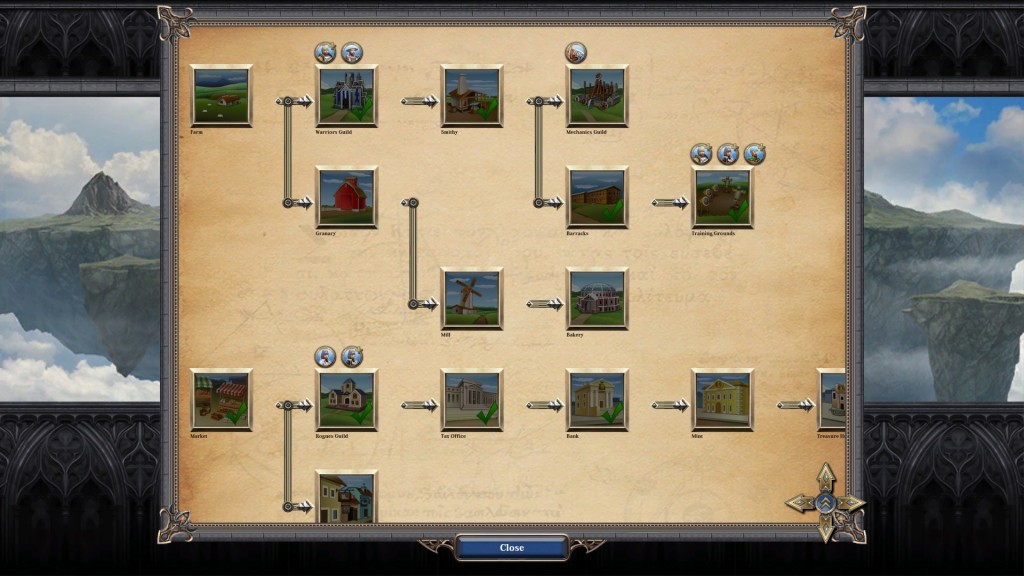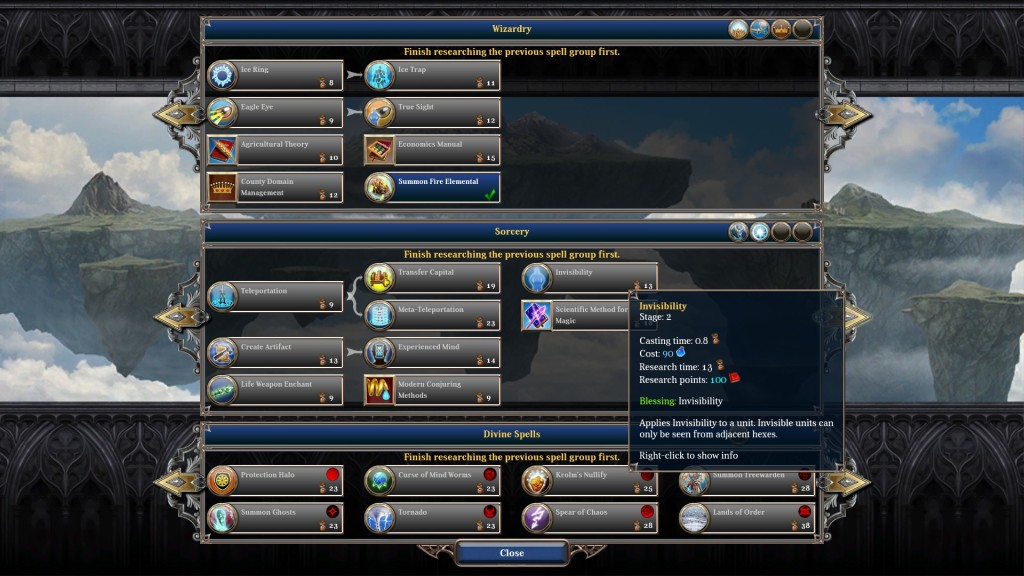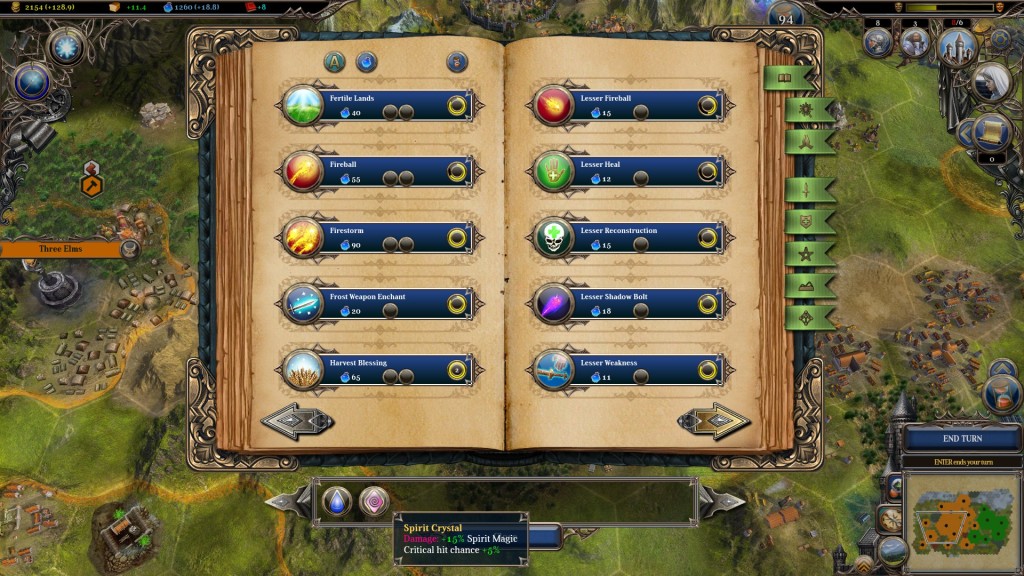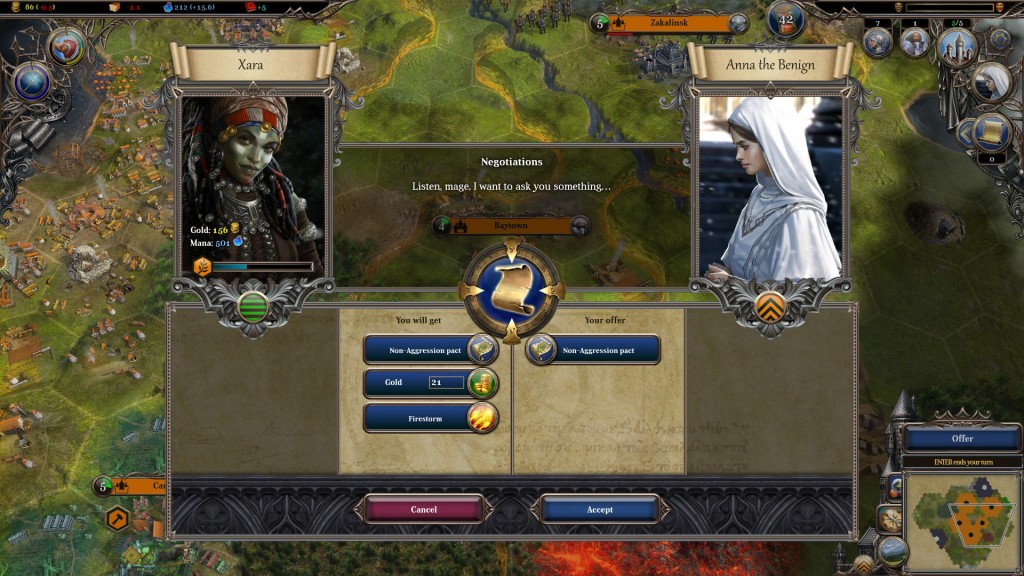- Waaaaaaaaaaaaar! Warlock: Master of the Arcane – The Verdict
- Warlock 2: Mage Versus World
- Warlock 2 and the 4X
My first scout killed some cockroaches and some wolves, then was mauled by a giant bear.
My second scout found some demonic trees and was turned into fertilizer before he could retreat.
My third scout killed some wolves and some weak spiders, reached level 3, and was immediately eaten by the giant killer spider lurking behind the weak spiders.
My fourth scout was diverted to help clean up a rogue infestation near my second city. After that he headed out into the fog and had dinner with some angry zombies. He was the main course.
My fifth scout killed the bear that killed my first scout, and discovered ogres. This was not a fortuitous discovery.
My sixth scout survived until the end of the game despite some hairy moments involving fire elementals, imps, vampire lords, sand golems…
My seventh scout found a trio of polar bearmen.
As the sequel to 2012’s Warlock: Master of the Arcane, Warlock 2 builds on that foundation and manages to make its predecessor all but obsolete. Warlock 2 offers most of 1‘s content, along with a bevy of new features, systems, modes, options and content. Unfortunately it also inherited the first game’s biggest flaw: weak AI opponents. As such, the game’s world is your main opponent, and what a hostile, merciless opponent it can be! The list above is a fairly standard record of the first 20 turns of my Warlock 2 games.
When I reviewed Warlock 1 at release I found it to be enjoyable, and a little unusual. It looked like Civilisation V, a similarity which only ran skin-deep. Far from being a 4X empire builder, it was a tactical wargame powered by copious magic, a hostile world, and unhinged comedy. Warlock 2 is no different, and in the crowded turn-based fantasy strategy game market of 2014 that’s all the more important. Warlock 2 is not directly comparable to Age of Wonders III, Endless Legend, Elemental, Eador, or any of the other releases which we’ve seen in the last year.
Warlock 2 takes place on a hex-based map that, depending upon the game mode and player-selected map generation options, can have multiple small offshoot maps accessed through portals. Each offshoot is themed to a certain type of terrain and enemy. A fire world will be filled with fire elementals, flame dragons, and other burning nasties, whereas an undead one might be filled with ghosts and zombies. Those monsters are always strong; exploring an alternate dimension is a task best left for the mid and late games. The early phases should be spent exploring the main map and settling new cities – not that this main map is much friendlier than the shards! The map begins covered in monster spawners, and new ones appear as the game progresses. As the name implies, the spawners pop out new units every now and then. When there’s a unit to guard the spawner, any new ones will roam. Spawners and spawnees vary in type and strength, from the easily killable giant cockroaches from a garbage dump all the way up to the gigantic blue magical spiders which are capable of hitting units so hard that they practically fly into their own pasts. Attracting attention from the wrong monsters early on will see your units die in a single hit, unable to do more than scratch their opponent should you be ‘fortunate’ enough to get an attack off. It’s best to move cautiously early on, lest you move three hexes into the fog and discover you’re ending your turn next to a killer. When fighting the more dangerous monsters, you’d better bring multiple units, tactics, and spell-support if you want to triumph. Leave the roamers too long, however, and they will eventually begin to head your way. Exploration is a serious and deadly business in Warlock 2, and that’s what makes it so enjoyable. Each spawner can be looted for gold, mana, spells and rare artefacts; there is always a reward to go with the risk.
Exile mode is perhaps the flagship addition in Warlock 2. It is a completely new mode of play, part scripted campaign and part sandbox. You play on a series of randomly generated shard maps, each themed to a specific element. The shards are linked together with portals. The effect is more like a gigantic, fragmented map than the series of maps as found in most strategy campaign modes. Each shard links to one or more other shards, and the order is again random. Most portals require participation in an event before they will open. Some of the events are simple enemy-generators which spawn a tough monster for the player to hunt down and kill. Others are more involved, offering series of multiple choice questions or decisions on whether to pay or fight. Other scripted events occur during the campaign, some of which can feel very challenging to deal with. One particular event sees a rival mage casting terraforming spells on the player’s domain every 10-20 turns, and this can wreak havoc with the player’s economy. The spells can be reversed provided the player researches the correct spells – but this requires time and mana, mana which may be needed to support efforts elsewhere. Getting him to stop requires a mini-quest chain of its own, and the resolution is not combat-based. I found the non-combat nature of the threat refreshing – although I said less kind things about it when the mage trashed my best gold-generating city by converting its terrain from tundra into fertile plains, then sank a large chunk of my mana-producing land under a deluge! While the shards and portal links are different for each exile mode game, the events are fixed.
All combat takes place on the main map; there is no separate combat mode or phase, and only one unit can occupy a hex, the same as in Civilization V. The map design does mean that there tends to be less of the awkward positional shuffling that takes place in that game; Warlock‘s maps contain fewer chokepoints, and it’s possible to give units abilities, such as flying, which let them bypass otherwise impassable terrain. While combat is not positional (there’s no flanking penalty), Warlock 2 has added support abilities as an added consideration. Units such as archers can attack at the same time as a friendly melee unit if they are arranged correctly. On the whole, combat is simple, intuitive, and fun. All melee units attack by standing next to their target, all ranged units by standing one hex away, all long-ranged units by standing two hexes away. Flying units can only be attacked by ranged units or other flying units. All units attack once, and melee units will retaliate when attacked unless you kill them with your attack. Terrain offers bonuses and penalties, such as a defence bonus for a unit attacked in hills or minor regeneration for a unit standing in living forests. Defence is split into 6 categories (melee, missile, life magic, etc), attacks are made from matching categories, and many units can provide multiple damage types. The interface will offer a detailed combat breakdown prior to you making an attack, including predictions on where the units’ health will end up. This enables you to see whether you want to commit to the attack, and lets you figure out why an attack is doing as much or little damage as it is. Altogether, this means that the player can focus on the neat questions (“What do I want my donkey knight to do?”) instead of the technical (“How does my donkey knight work?”), as well as always knowing roughly what to expect from a unit as soon as it’s sighted on the map. In a game with so many units this is generally a good thing.
Units gain levels, can be given perks, and can have buffs cast on them – it’s an understatement to say there’s real scope to customise your units or build up cherished powerhouses. Some units start with skills and perks on recruitment. Each level-up offers the chance to select one perk out of a range of three. Further perks can be added by building the correct building on a special resource (e.g. a silversmith on a silver mine). This grants 5 uses of the perk, to be assigned as and when you please. Those 5 uses are permanent: you do not get them back if the unit dies, and you cannot cancel them once given. To get more uses you must build another building on another copy of the resource. This makes perks something precious, to be handed out to your heroes and favourites. The more disposable rank and file will have to do without protective amulets, pumpkin god blessings, healing herbs, and dwarven armour. Buffing spells are more open, with the only limit being your ability to sustain the per-turn mana maintenance cost. Yes, if you want, you can make your entire army fly, then stack on multiple defensive and offensive boosts, HP regeneration, line of sight boosts, and whatever else takes your fancy! This unit customisation is tremendously enjoyable, and it can be very satisfying to build a unit up from fresh-faced newbie to unstoppable elite so laden with buffs and perks that he can’t sneeze without destroying worlds.
As perks are now limited, so too are cities. Warlock 2 has introduced a city limit and population unhappiness mechanic. You have an optimal number of cities, and going above that number causes a small amount of steadily accumulating unrest. The further you are above your optimum number, the faster the unrest grows. It is possible to raise the optimal number of cities via research. For players who want more cities, it is possible to place a city down and designate it a ‘special city’. This means that you relinquish personal control of it in return for a set, stated benefit. Free cities will give you 10 gold per turn, holy cities will give a relationship bonus to the designated god, fortress cities act as tough defensive structures. Special cities do not count towards the limit and so the player is free to wallpaper the map in them if they so choose. Free cities do not work special resources or contribute them to their parent empire. The idea is to cut down on late-game micromanagement, and to force the player to make choices about which resources and buildings are essential. It is an interesting concept, and it is certainly worth trying for a game or two even if you are dubious about it. If it’s not your cup of tea, don’t worry – there’s an option to disable it. The limit is also fully moddable, so if the default seems too tight it’s possible to increase it without entirely disabling the feature.
Research has been completely overhauled in Warlock 2. The random system from the first game is gone, swept aside in favour of a pair of research trees. The new trees are not fully linear. Some spells act as prerequisites to others. Other spells are isolated and independent. Researching a set number of spells at one level will open up the next level. For example, you might have 10 tier 2 spells available to research. On researching four of them, tier 3 opens up. The two parallel trees are loosely split between damage & realm boosts, and unit buffs/debuffs and support abilities like teleport. This gives the player a lot more control over research, and poses some moderate decision-making.
As for spells themselves, there’s not much which needs to be said. There’s a wide variety of them, they’re all easy to use, and they’re mostly very handy. You will want to buff your units and call in the heavy magical artillery to land supporting shots in tough combats. It’s a practical and functional part of the player’s repertoire, not a shiny toy to play with on the side. So far, so very Warlock 1. New to Warlock 2 are glyphs, special crystals which can be added to a spell to change its properties. The range of effects is quite comprehensive, and the more powerful bonuses tend to be paired with penalties. Once the necessary research is completed spells can also be used to create powerful artefacts for your heroes.
The rival AI is the game’s weakest point. Regardless of the difficulty setting, the AI-controlled great mages are a hapless bunch. They barely expand in the opening phase of the game, typically waiting until I’ve cleared the hostile monsters and locked down a large portion of the map under my control. I noticed that they performed slightly better when I turned the frequency of monster spawns down, so I would guess that the AI is struggling to survive in the lethally hostile world, losing plenty of units to roaming monsters and getting its settlers eaten. Once the world is a bit safer the AI can and will expand, plonking cities all over the map with mixed success. Sometime sit chooses a good location, others it settles with special resources 1 hex out of the city’s workable range. Warlock 2‘s AI is more restrained in its unit recruitment than 1‘s was at release. This is both a blessing and a disappointment. A blessing because Warlock 1 recruited hordes of low-level units which posed little threat to the player but still needed killing. A disappointment because Warlock 2‘s AI is doing a better job of recruiting quality units, and so could pose more of a threat if it recruited more of them and used them in a more coordinated fashion.
It’s not all bad news on the AI front, however. The AI is now willing to make peace, and maintain it. It will offer alliances, and keep them too. I have witnessed the AI sending units to mop up hostile spawns within my territory, and it has cast spells on my enemies to help me out. In approximately 40 hours of play I have not been betrayed by the AI once. In the first game the AI was so player-hostile there was no point in attempting diplomacy, so this is a welcome step forward. Diplomacy is basic – there are options for truces, alliances, and gold/mana/spell trades – but the game does not need much more than that. It’s a wargame, after all. It would be nice to have options to set up a team and work together with one or more AI mages against a dangerous rival, should the AI advance to the point where such measures become useful.
The AI has received work in multiple patches since release, and both developer Ino-Co and publisher Paradox have repeatedly stated that the AI remains a focus for improvement. I shall be interested to see how things develop.
Inco-Co and Paradox have been responsive to player requests, and their additions to the game is the main reason this review has taken me several weeks. They have added new modes and new options, all of which I have happily taken for a test drive. Additions include the option to control monster spawn rates, a sandbox variant of exile mode’s shard set-up, a toggle for city limits, and two new world types. The last update added a DLC store to the game’s main menu. It appears that DLC will be purchased through the game rather than through Steam’s storefront. Thus far the DLC is all fluff like minor starting perks, and is easy to pass over – I do not feel that the game is incomplete in any way without this DLC.
The first game’s comedy remains intact. For those of you who did not play the first, this means a narrator who sounds like Sean Connery, donkey-riding knights (the Order of Stubborn Knights), werewolves in top hats, pumpkin farms which produce a “hill-o-win” unit perk, and all sorts of other barminess. The unit descriptions are often lightly comedic too, and certainly worth reading unless you’re allergic to the Ardanian sense of humour.
The game has a suite of mod tools, along with documentation to support them. I’m not a modder so I did not try any of the tools; however, I did notice frequent lines in the patch notes reporting changes to make modding easier. Both Ino-Co and Paradox representatives are active on the forums, stating a wish to support modding and make Warlock 2 accessible to modders. The game features full Steam workshop support.
In the end I find my closing position on Warlock 2 is similar to that of the original: if you want a fantasy empire builder, or a game with lots of options away from warfare, look elsewhere. If you want a fantasy wargame where you field a small but increasingly personalised army of units to fight against a cruel world and occasionally trample an AI mage who got in the way, Warlock 2 is a fine game and recommended.
The basis of this review:
Time played: approximately 40 hours, 16 online and recorded by steam and 20-25 in offline mode due to problems with the steam server.
Modes played: multiple sandbox maps on various settings, including victories on normal and the highest difficulty. 1 exile mode game with the largest map settings.
Discover more from Matchsticks for my Eyes
Subscribe to get the latest posts sent to your email.
